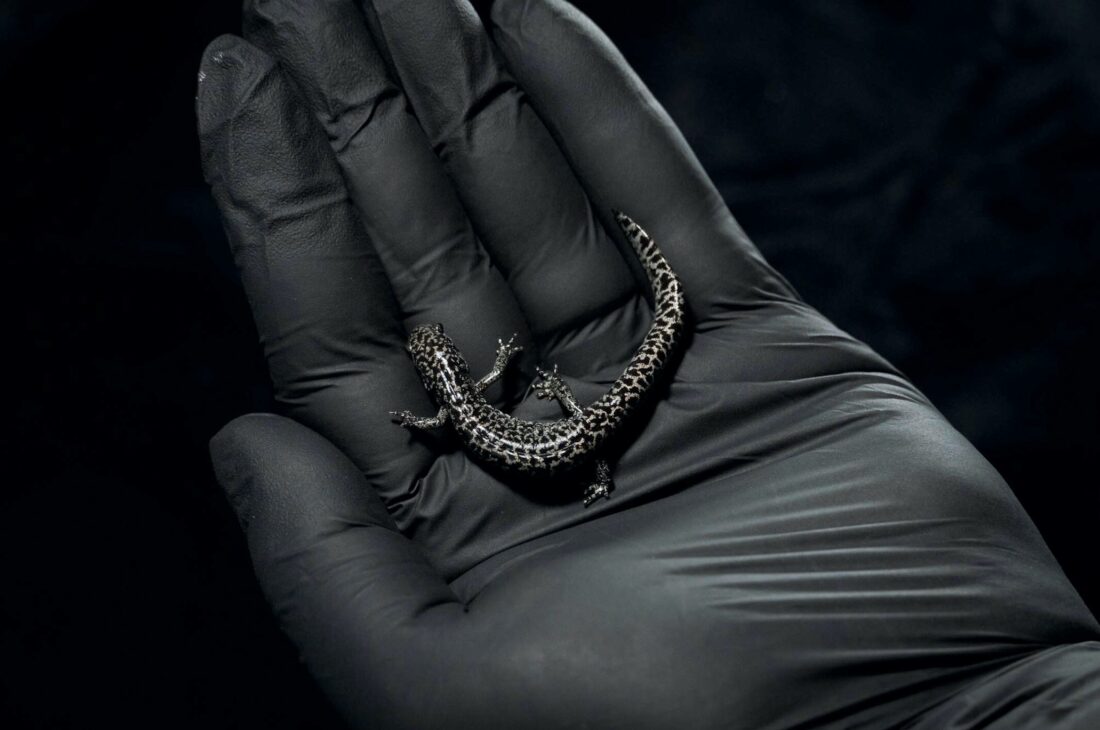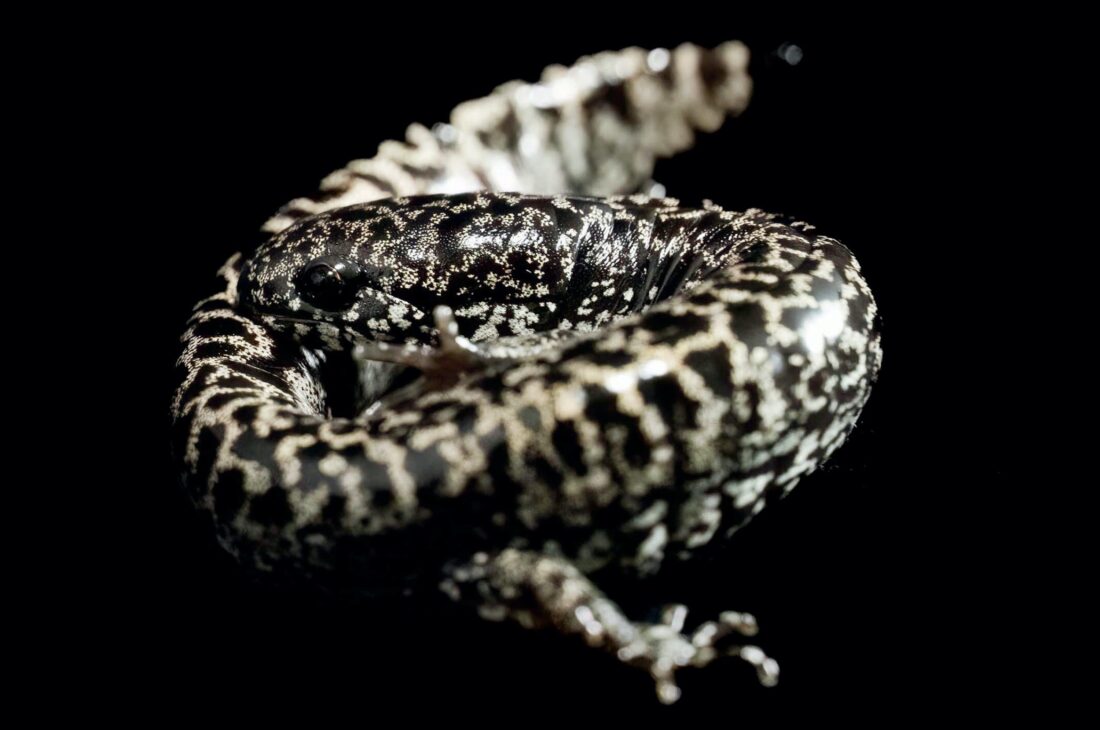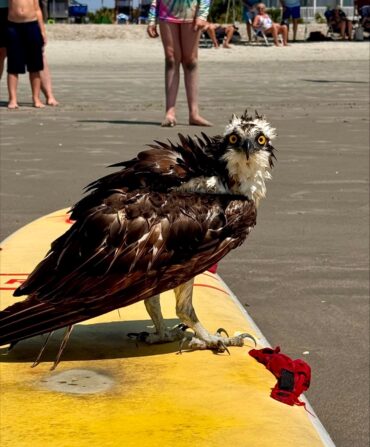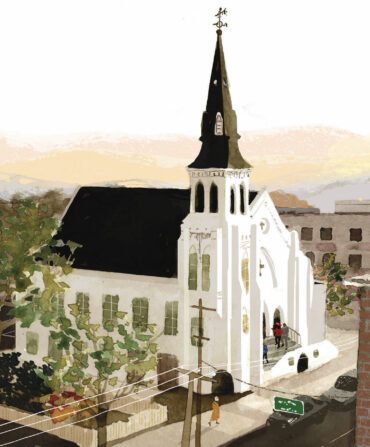When herpetologist Mark Mandica’s thirteen-year-old son peered into an enclosure of frosted flatwoods salamanders in late December 2021 and said, “Dad, there’s eggs in there,” Mandica didn’t believe him. But on closer examination, Mandica spotted the jellylike orbs, attached to blades of grass. “We were overjoyed,” Mandica recalls. “We stood in the dark, hugging, because we’d been working toward this for a decade.”
Back then, the little-known, little-studied amphibian—once abundant in longleaf pine ecosystems—was nose-diving to extinction. And Mandica, a researcher who pivoted to conservation work in response to global amphibian declines, was all too familiar with species loss: While working as the amphibian conservation coordinator at the Atlanta Botanical Garden, he cared for the last known male Rabbs’ fringe-limbed tree frog of Panama. In 2016, the lonely frog—dubbed Toughie—died. “The finality of it was profound, and there was nothing I could do but make him comfortable,” Mandica says. “It’s still a salt-in-the-wound topic.”
That same year, he and his wife, Crystal, started the Amphibian Foundation (AF), a conservation nonprofit, in Atlanta, to focus on the frosted flatwoods salamander (the frostie, for short), a species Mandica had begun searching for a few years before. “I couldn’t stand by while we lost one of our own amphibians in the Southeast,” he says. The foundation aimed to create a captive colony for a worst-case scenario. Due to the scarcity of longleaf habitat, along with the disruption of the wetlands where the salamanders breed thanks to climate change, just three frostie populations are hanging on in Georgia and Florida. They’ve suffered a population decline of more than 90 percent since 2000.
Female frosties lay their eggs in dry depressions in the forest near the edges of ephemeral ponds, gambling that the hollow will fill with water and allow the eggs to hatch and enter their aquatic larval phase. Mandica and his team crawled on hands and knees, searching for eggs. They surveyed for larvae, too, and took to the lab those with little chance of survival otherwise. In time, they established the only captive colony in the world (“talk about pressure,” Mandica says). But despite his best efforts to puzzle out the conditions they needed to breed, it took five years for him to finally hit on the right moisture, humidity, and light levels and for eggs to appear.
“He called me that morning, beside himself,” recalls Harold Mitchell, the frosted flatwoods salamander species recovery lead for the U.S. Fish & Wildlife Service and a partner in Mandica’s efforts. “I wanted to pass out cigars like a new dad. It was a total game changer.” Twenty of those eggs reached metamorphosis last summer.

Modeling estimates it’ll take an output of 2,800 frosties each year, however, before they can be consistently reintroduced to the wild. “Those are high numbers, but that’s the riddle Mark is solving,” Mitchell says. “If he can get this to happen regularly and export the methodology, then we start seeing the light at the end of the tunnel to reach recovery.” Mandica has sent young salamanders to four partner institutions—a U.S. Fish & Wildlife hatchery in Georgia, Brevard Zoo in Florida, the North Carolina Zoo, and Henry Doorly Zoo and Aquarium in Nebraska—to start new colonies. And he hopes his own salamanders will breed again this year; about ninety currently reside in a special lab at AF, and another three hundred live in outdoor mesocosms (which re-create their habitat) down the road.
All that effort for an obscure salamander that spends most of its life underground may mystify some, but frosties and their brethren play key ecological roles. Salamanders, more abundant by total mass than mammals and birds combined, prop up ecosystems—preying on invertebrates while being preyed upon by vertebrates. They’re little protein packs that feed the forest and lace the food chain together, each species representing an ancient story of evolution tied to the land that shaped them over millions of years. A stunning array live in the Southeast—more than almost anywhere else in the world. They come in all colors and shapes: brilliant red, moss green, wrinkled and brown, sleek and aquatic, fat and terrestrial.
At AF, Mandica shows me a single frostie, just a year old, curled beneath a makeshift log. The male is smooth and black, with delicate toes, big eyes, and sprinkles of icy white tracing fantastic patterns across the body—a secret of the forest most people will never see. The battle for the species’ existence will play out quietly, as the effort to breed them in captivity did in this lab. But the fragile creature has the best that the many threatened amphibians of the South can hope for—a team to fight for it, and therefore a fighting chance.









